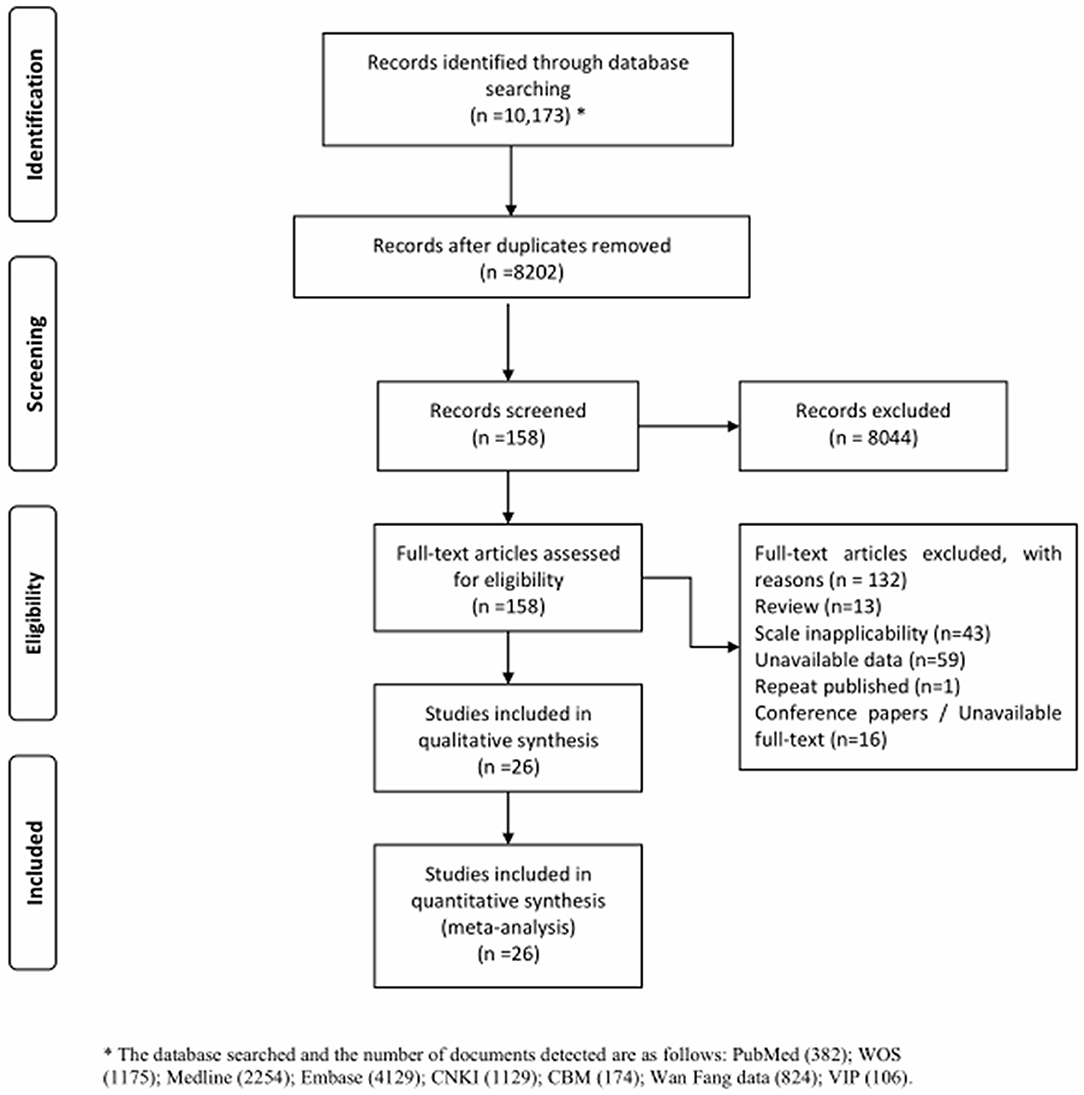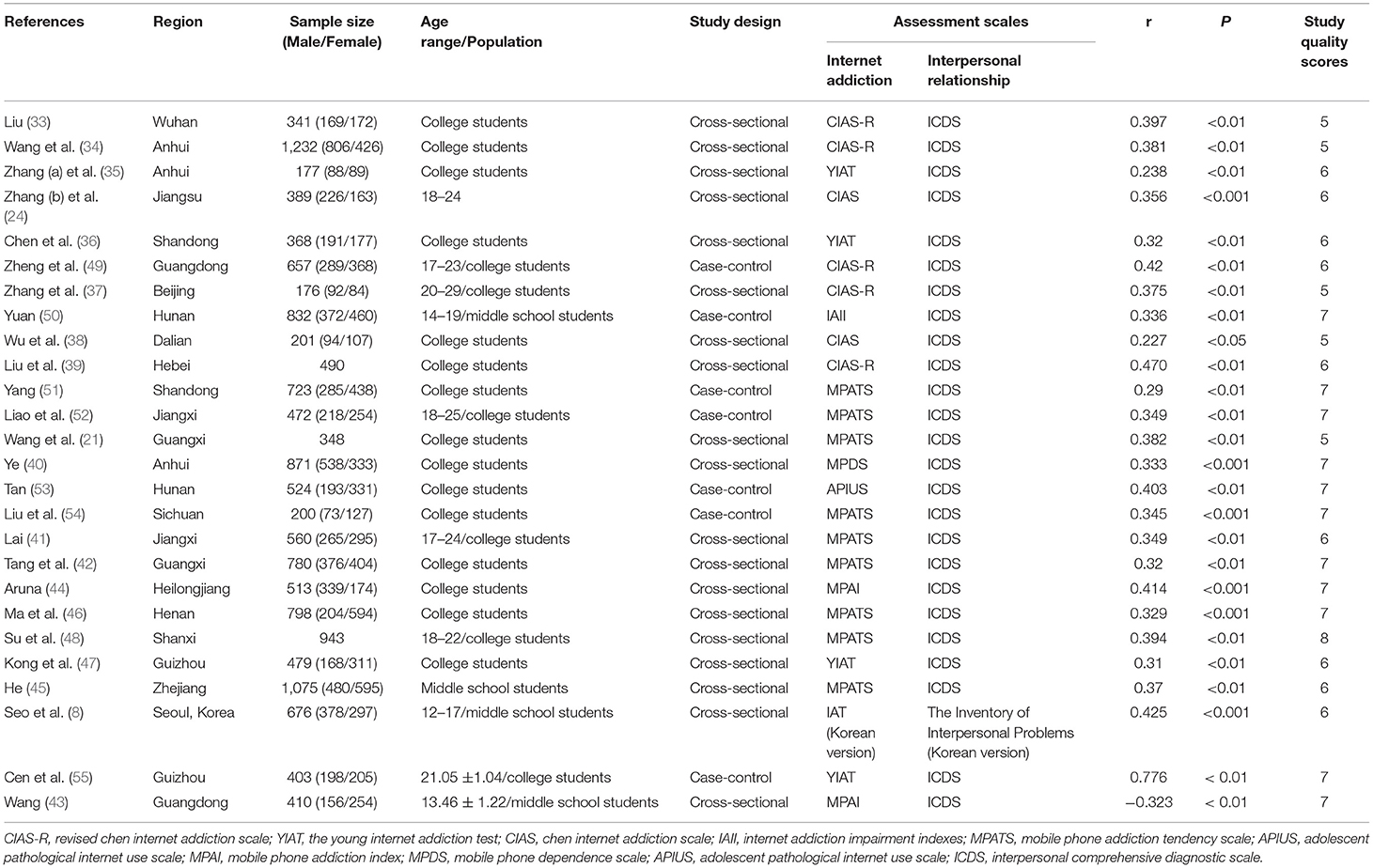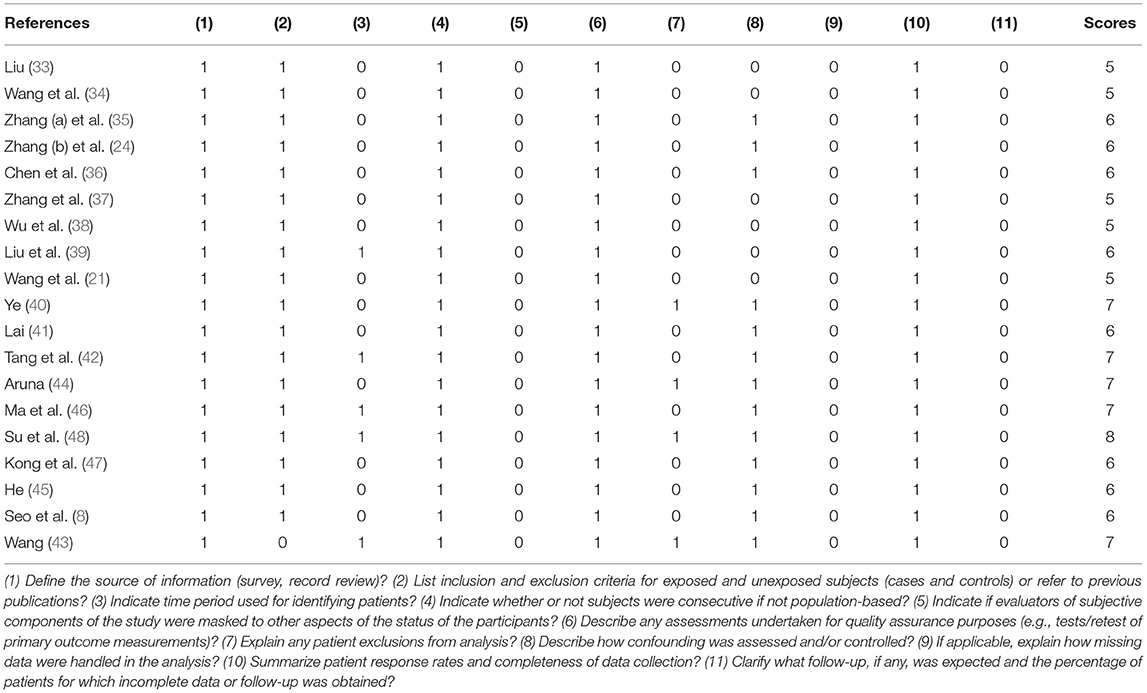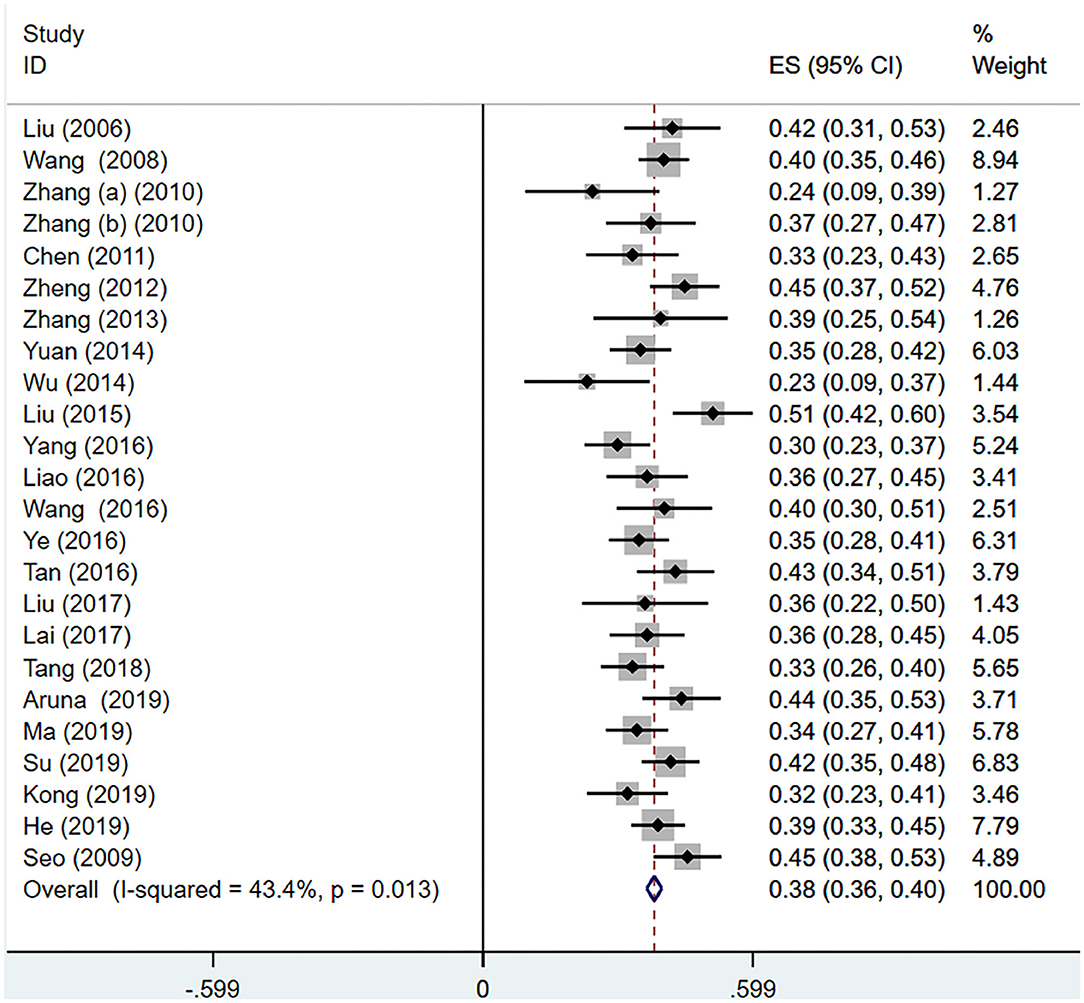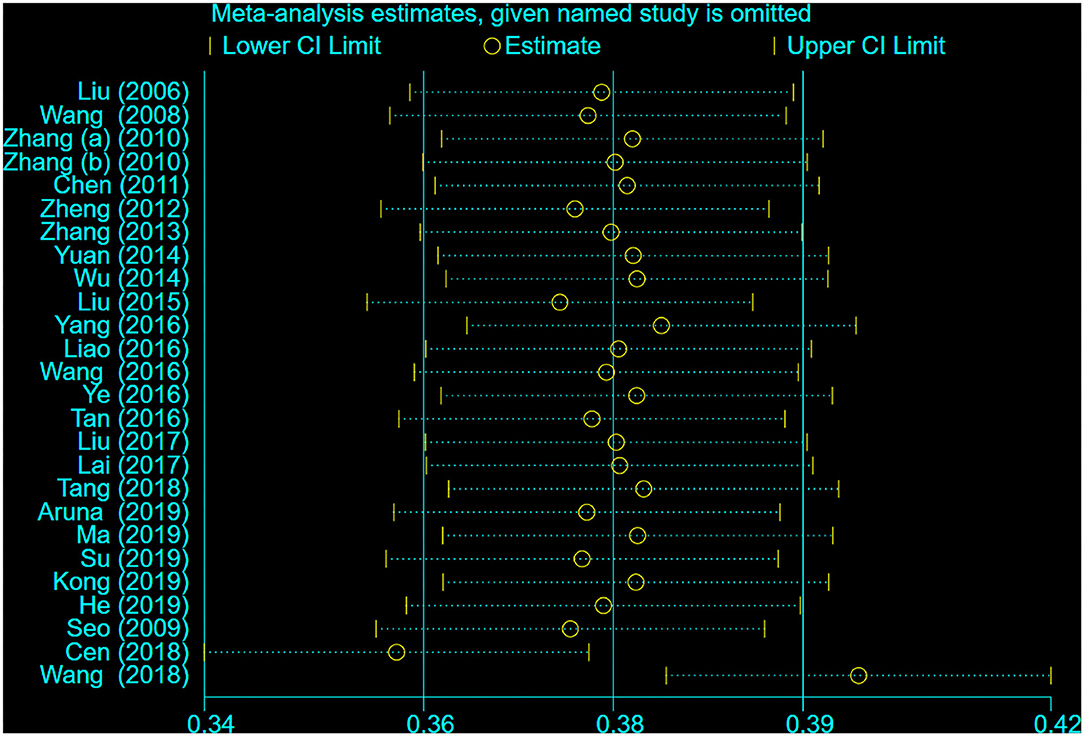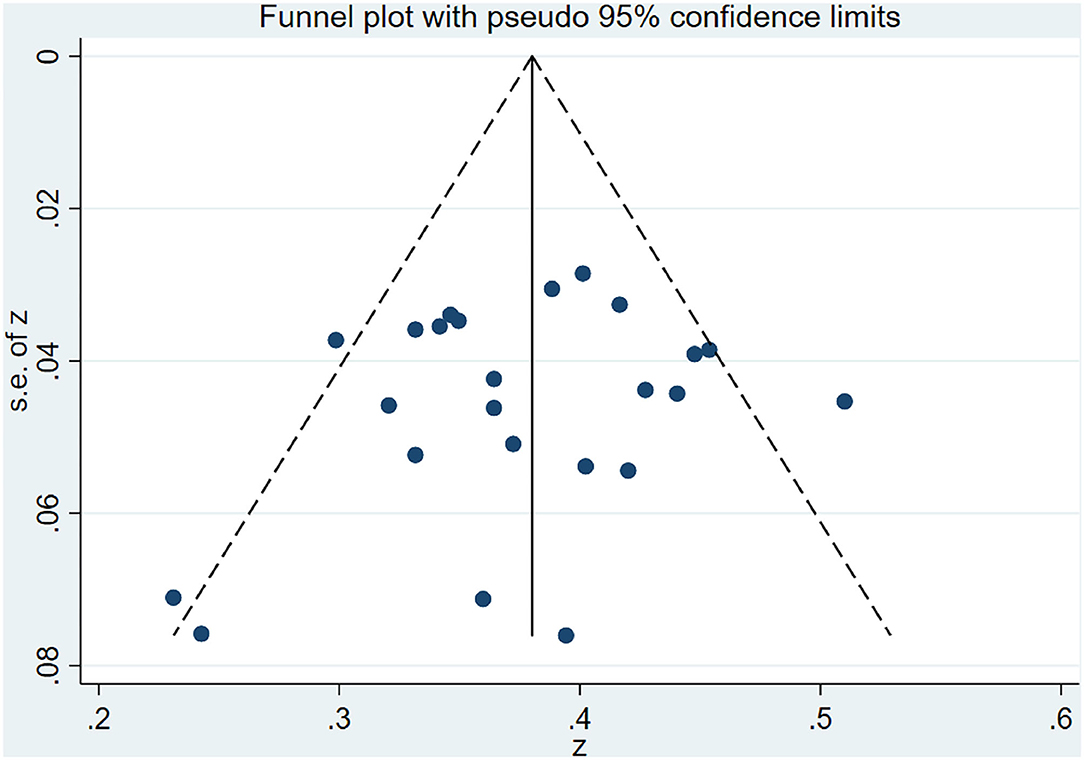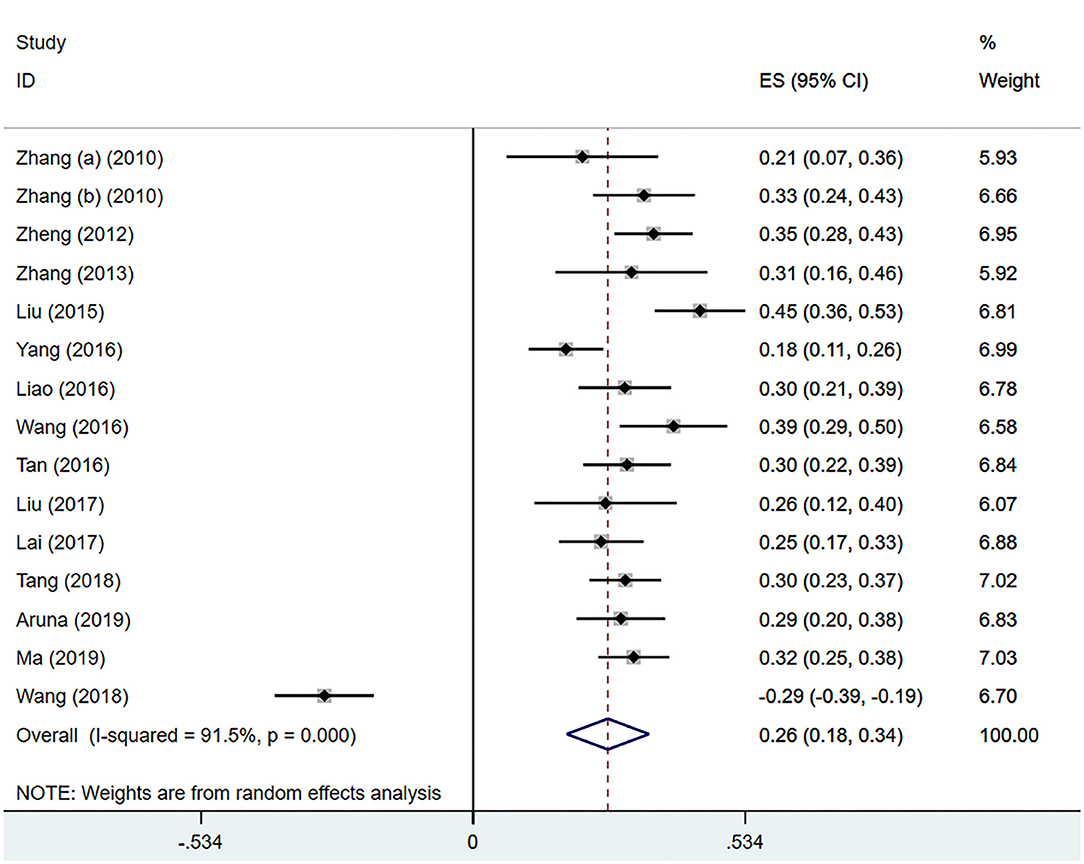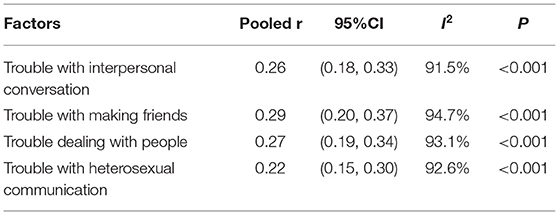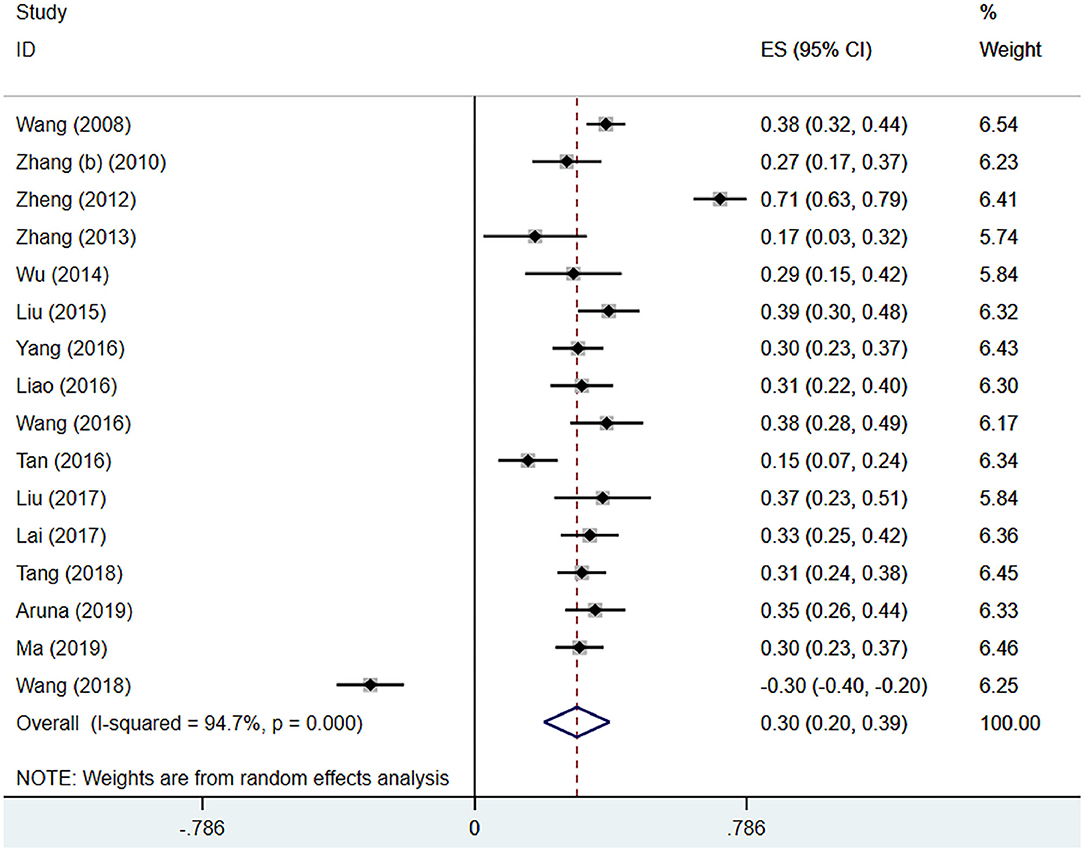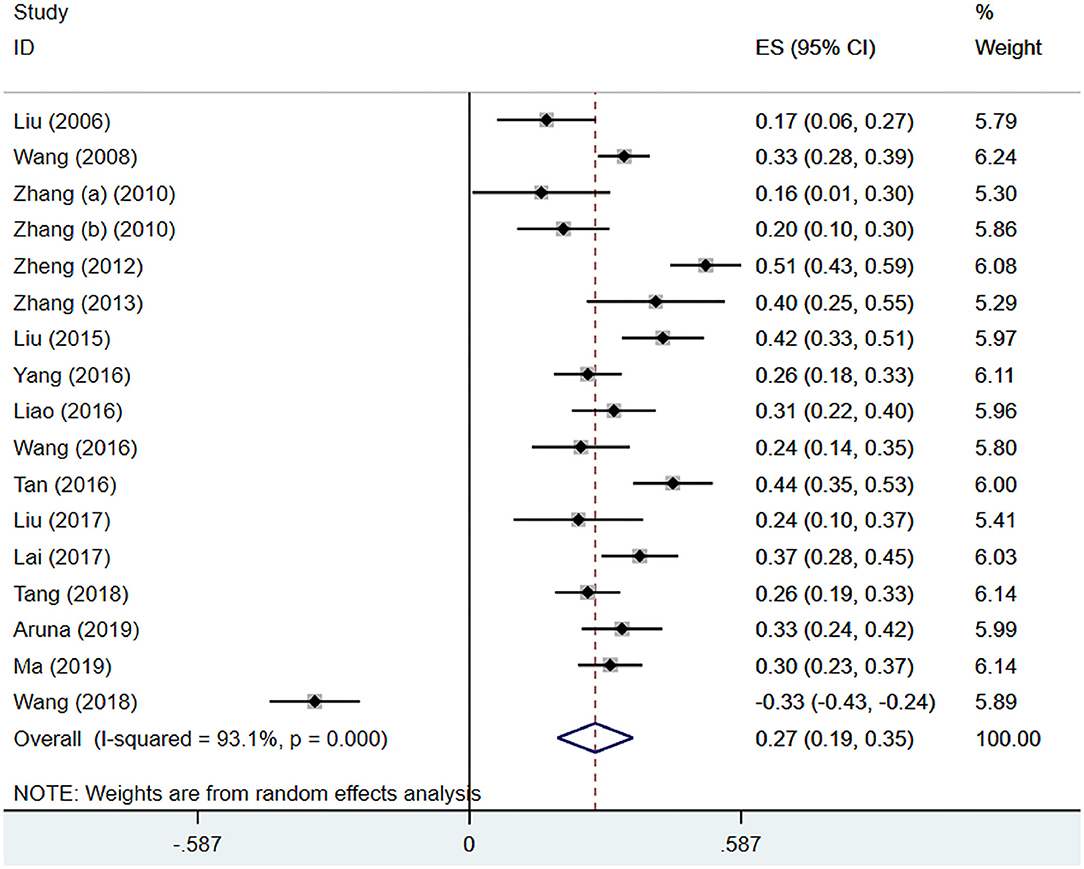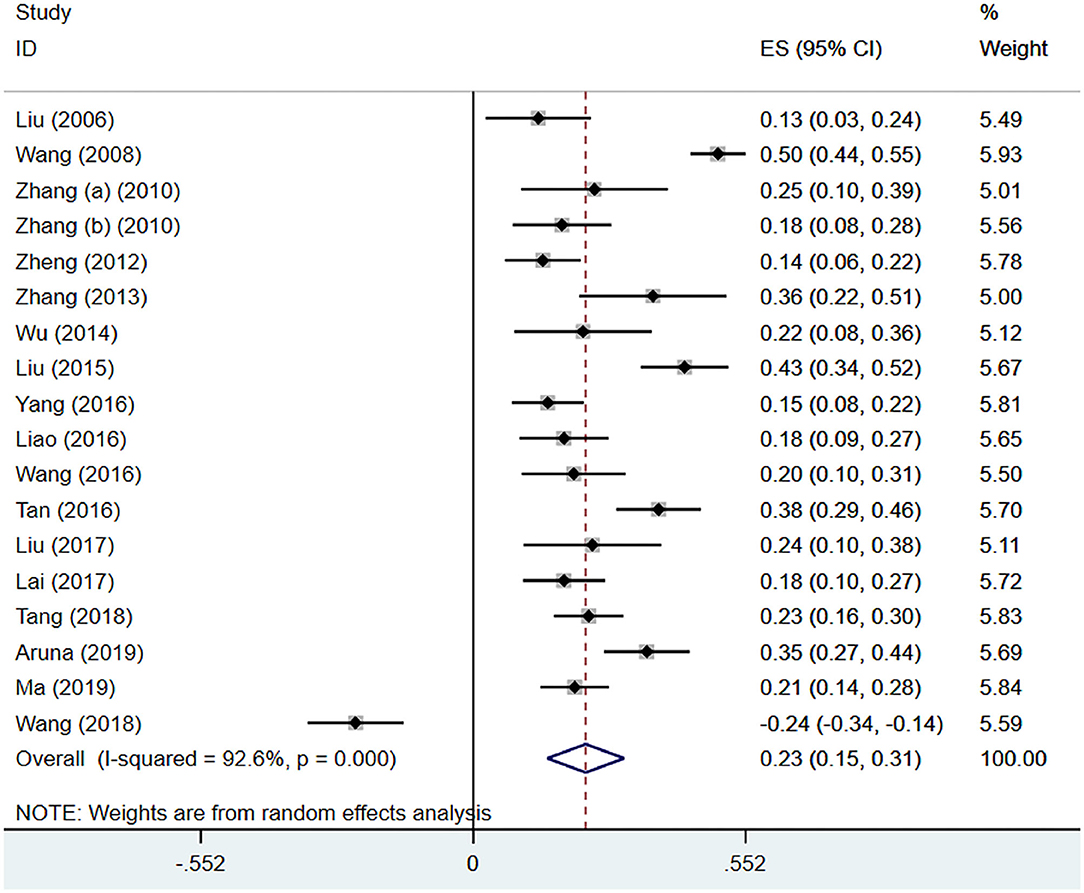- 1School of Rehabilitation and Health Preservation, Chengdu University of Traditional Chinese Medicine, Chengdu, China
- 2School of Acupuncture and Tuina, Chengdu University of Traditional Chinese Medicine, Chengdu, China
- 3School of Preclinical Medicine, Chengdu University, Chengdu, China
Background: Internet addiction (IA) has become a serious social issue, inducing troubles in interpersonal relationships, which may negatively impact the healthy development of teenagers and college students. Thus, the current research aimed to synthesize the available evidence to clarify the correlation between IA and troubles in interpersonal relationships.
Method: We searched eight electronic databases from inception to December 2020. Study quality was assessed by the Newcastle-Ottawa Scale (NOS), and Agency for Healthcare Research and Quality (AHRQ). We analyzed the data by extracting the Pearson correlation coefficients of each study and converted it into Fisher's Z. Pooled r was conducted by Fisher's Z and standard error (SE). STATA (Version 15.0) software was used for data synthesis.
Results: A total of 10,173 studies were initially identified, and 26 studies (n = 14,638 participants) were retrieved for further analysis. The results indicated that there was a significant positive correlation between IA and interpersonal relationship troubles [0.36 (95% CI 0.35–0.38)]. In addition, there was a positive correlation between IA and different dimensions of interpersonal relationship reflected by troubles with interpersonal conversation, making friends, dealing with people, and heterosexual communication, with the result of [0.26 (95% CI 0.18–0.33)], [0.29 (95% CI 0.20–0.37)], [0.27 (95% CI 0.19–0.34)], [0.22 (0.15–0.30)], respectively. The Egger test suggested that there was no publication bias (P > 0.05).
Conclusion: IA is positively correlated with troubles in interpersonal relationships. This research will provide new ideas and direction for further intervention, clinical therapy, and policy-making regarding IA to some extent.
Systematic Review Registration: https://www.crd.york.ac.uk/prospero/, identifier: CRD42020177294.
Introduction
Internet addiction (IA), described as a behavioral addiction, manifested as repeated and unrestrained use of the internet, induces a series of cognitive and social impairments (1–3). With the advancement of the internet, IA is widely prevelant among teenagers in many countries around the world, reaching a maximum of 57.5% (4–6). Teenagers and college students are the main groups who use the internet, and among all internet devices, mobile phones are the main tool for them to surf the internet (7). In modern society, the internet is certainly important, but a series of public health problems caused by it cannot be ignored. At present, many studies have shown that IA is related to the troubles in interpersonal relationships among teenagers and college students (8, 9).
Interpersonal relationships are a phenomenon that exists only in human society, and there is no unified definition at present (10). Some scholars believe that definitions of interpersonal relationships emphasize a mutual process, that is, a bond among people that arises in the process of mutual contact due to common needs (11, 12). The Interpersonal Comprehensive Diagnostic Scale (ICDS) compiled by Zheng (13) is divided into four dimensions (trouble with interpersonal conversation, making friends, dealing with people, heterosexual communication), which can better reflect the interpersonal relationship troubles of teenagers and college students. Adolescence is a critical period for physical and mental development, during which the development of positive interpersonal relationships is the foundation for entry into society (8). On the contrary, if effective interpersonal relationships are not developed, various psychological issues will arise, such as depression, anxiety, aggression, and maladjustment (14–16). What is more, many studies have found that IA is an important factor influencing interpersonal relationships (9, 17, 18). This is probably due to the convenience, anonymity, and virtuality of the internet being more likely to arouse their attention (19). Therefore, it is necessary to investigate the correlation between IA and troubles in interpersonal relationships among teenagers and college students.
There have been many related studies discussing the relationship between IA and interpersonal relationship troubles. The study by Lo et al. (20) about 174 online gamers among Taiwanese college students found that with increased time spent in game, issues with interpersonal relationships appeared, and social anxiety increased. The research by Wang et al. (21) pointed out that the degree of mobile phone addiction is slight, but their outlook for interpersonal troubles was not optimistic. At the same time, this study also showed that there was an obvious positive correlation between mobile phone addiction and the interpersonal troubles of college students. However, the study by Li (22) indicated that IA had a weak effect on interpersonal relationships. A study by Dai (23) showed that the interpersonal relationship and IA of teenagers were not significantly related. Otherwise, in terms of different dimensions of interpersonal relationships, the study by Zhang (24) believed that heterosexual communication and interpersonal conversation were significantly related to IA. However, the results of different studies were not consistent (25, 26). Therefore, for these inconsistent results, we chose a meta-analysis to summarize the current studies with the aim of obtaining a consistent finding.
Materials and Methods
This systematic review was conducted in accordance with Preferred Reporting Items for Systematic Reviews and Meta-Analyses (PRISMA) (27). The systematic review protocol has been registered in PROSPERO with registration number is CRD42020177294.
Literature Search
PubMed, Embase, Medline, Web of Science, China National Knowledge Infrastructure (CNKI), China Biology Medicine (CBM), Wan Fang data, and the Chinese Science and Technology Periodical Database (VIP) were be searched for relevant studies in Chinese and English before December 2020. In addition to the electronic databases, we also searched conference papers, dissertations, and reference lists of relevant reviews, so as to ensure the integrity of the inclusion of the literature. The search strategy is shown in Supplementary Material 1.
All retrieved literature was managed using Endnote X9 and repeated records were filtered. Two authors (QH and JW) independently screened the articles according to the title and abstract based on the pre-set inclusion criteria. They then downloaded the full text of all possibly relevant studies, and further reviewed the full text independently. They cross-examined the included studies, and the differences were resolved through discussion or consensus with third-party reviewers (WP).
Selection of Articles
Types of Studies
All observational studies including cohort, case-control, and cross-sectional studies were included if a correlation between IA and interpersonal relationship troubles were reported as an outcome before December 2020. And all studies provided effective Pearson correlation coefficients. Other types of studies including reviews, case reports, meeting abstracts, and commentaries were excluded.
Types of Participants
The study participants were teenagers and college students who were diagnosed with IA. No limitation was exerted upon gender.
Types of Intervention and Comparison
Because this study was a correlation meta-analysis, it did not involve grouping. So, there is no strict setting of the intervention and comparison group.
Types of Outcomes
The main outcomes were the scales related to IA and interpersonal relationships. Pearson correlation coefficients reported by each study was used to further analyze the correlation between IA and troubles in interpersonal relationship.
The secondary outcomes were the correlation analysis between different dimensions of interpersonal relationships and IA.
Data Extractions
Two authors (QH and JW) independently extracted the data with a pre-defined data extraction form, including general characteristics (first author, year of publication, language, and research country/region), characteristics of participants (sample size, average age, sex, study population), other characteristics (IA diagnostic criteria, measurement tools used, interpersonal categories) and outcomes (scale scores, correlation coefficient between them and P-value, main results). Of course, it also included more information related to this study.
Quality Assessment
In this study, the Newcastle-Ottawa Quality Assessment Form (NOS) (28) was utilized to access the quality of the case-control studies, which included three quality parameters (selection, comparability, and results). The Agency for Healthcare Research and Quality (AHRQ) (29) was utilized to access the cross-sectional studies, including 11 items. The score of 0–3 was classified as low quality, 4–7 was classified as medium quality, and 8–11 was classified as high quality. All stages of the quality assessment process were independently performed by two authors (QH and JW). The differences were resolved through discussion or consensus with third-party reviewers (YT).
Data Analysis
We extracted the Pearson correlation coefficients (r) of each study and conducted a meta-analysis about the correlation between IA and troubles in interpersonal relationships among teenagers and college students. After converting the Pearson correlation coefficients (r) into Fisher's Z and SE, the final effect size was calculated as the pooled r and 95% confidence interval (95% CI). The same methods were used to analyze the correlation between IA and different dimensions of interpersonal relationship. The heterogeneity of the r-values between studies was determined by calculating the Q statistic, which derived from the chi-square test, and the inconsistency index (I2) (30, 31). If p < 0.05 or I2 > 50%, the heterogeneity was indicated (32). If significant heterogeneity was found, sensitivity analyses were performed on all studies to further investigate the heterogeneity of the studies. In addition, publication bias was conducted by funnel plot. Besides, Egger's test was to be carried out. All procedures were executed by STATA (Version 15.0) software.
Results
Literature Search
Through searching the database using our search strategy, 10,173 studies were initially identified, and 8,202 studies remain after deduplication with Endnote X9. After screening the titles and abstracts, a total of 158 studies required full-text evaluation. Finally, 26 studies were included in this systematic review and meta-analysis. The detailed screening process was shown in a PRISMA flow diagram (see Figure 1).
Study Characteristics
A total of 26 studies were included in this review, with a total of 14,638 participants. The studies included in this study were observational studies, including 19 cross-sectional studies (8, 21, 24, 33–48) and 7 case-control studies (49–55). Regarding the tools used to assess IA, five studies (33, 34, 37, 39, 49) used Revised Chen Internet Addiction Scale (CIAS-R), four studies (35, 36, 48, 55) used Young Internet Addiction Test (YIAT), two studies (24, 38) used Chen Internet Addiction Scale (CIAS), two studies (43, 45) used Mobile Phone Addiction Index (MPAI), 1 study (50) used Internet Addiction Impairment Indexes (IAII), nine studies (21, 41, 42, 45, 46, 48, 51, 52, 54) used Mobile Phone Addiction Tendency Scale (MPATS), one study (40) used Mobile Phone Dependence Scale (MPDS), one study (53) used Adolescent Pathological Internet Use Scale (APIUS), and one study (8) used the Korean version of Internet Addiction self-test scale. Regarding the evaluation of interpersonal relationships, except for the study by Seo et al. (8), which used the Korean version “Inventory of Interpersonal Problems,” almost all studies used the Interpersonal Comprehensive Diagnostic Scale (ICDS). The basic characteristics of the included studies were summarized in Table 1.
Methodological Quality
In this review, the AHRQ scale was used to evaluate cross-sectional studies, and the NOS scale was used to evaluate case-control studies. Through the evaluation, we found that the overall quality of included studies was good, and there were no low-quality studies. The detailed information about methodological quality assessment was presented in Tables 2, 3.
Meta-Analysis Results
By extracting the correlation coefficient between IA and interpersonal relationships in different studies, and after appropriate conversion, we conducted a meta-analysis of included studies. Knowing from the forest plot, the pooled effect size (z) was 0.37 (95% CI 0.30–0.44). After conversion, the pooled r was 0.36 (95% CI 0.30–0.41), and there was significant heterogeneity among studies (I2 = 94.1%, P < 0.001).
Sensitivity Analysis
The sensitivity analysis was carried out to discovered the source of heterogeneity. We found that the studies of Wang (43) and Cen (55) were the source of high heterogeneity. Then, we recalculated the pooled r after removing these two studies, the pooled r was 0.36 (95% CI 0.35–0.38), and there was no significant heterogeneity (I2 = 43.4%, P < 0.05; see Figure 2). The result of sensitivity analysis is shown in Figure 3.
Publication Bias
After removing two high heterogeneity studies, the funnel plot was basically symmetrical (see Figure 4). The Egger's test suggested that there was no publication bias (P > 0.05).
Meta-Analysis Between IA and Different Dimensions of Interpersonal Relationship
We analyzed the statistically significant data that provided different factors' coefficients of ICDS in the included studies. Through analysis, we found that there was some heterogeneity among studies. However, through sensitivity analysis and after removing some studies, we found that the overall effect size did not change substantially (I2 > 50%), so we chose the random-effects model. In addition, the results should be treated with caution due to their high heterogeneity.
IA and Trouble With Interpersonal Conversation
Fifteen (21, 24, 35, 37, 39, 41–44, 46, 49, 51–54) studies mentioned the meaningful correlation coefficients of interpersonal conversation trouble factors. Through analysis, there were a large heterogeneity (I2 = 91.5%, P < 0.001), and the pooled effect size (z) was 0.26 (95% CI 0.18–0.34; Figure 5). After conversion, the pooled r was 0.26 (95% CI 0.18–0.33; Table 4).
IA and Troubled With Making Friends
Sixteen (21, 24, 34, 37–39, 41–44, 46, 49, 51–54) studies mentioned the meaningful correlation coefficients of trouble with making friends. Through analysis, there was a large heterogeneity (I2 = 94.7%, P < 0.001), the pooled effect size (z) was 0.30 (95% CI 0.20–0.39; Figure 6). After conversion, the pooled r was 0.29 (95% CI 0.20–0.37; Table 4).
IA and Trouble Dealing With People
Seventeen (21, 24, 33–35, 37, 39, 41–44, 46, 49, 51–54) studies mentioned the meaningful correlation coefficients of trouble dealing with people. Through analysis, there was significant heterogeneity (I2 = 93.1%, P < 0.001), the pooled effect size (z) was 0.27 (95% CI 0.19–0.35; Figure 7). After conversion, the pooled r was 0.27 (95% CI 0.19–0.34; Table 4).
IA and Trouble With Heterosexual Communication
Eighteen (21, 24, 33–35, 37–39, 41–44, 46, 49, 51–54) studies mentioned the meaningful correlation coefficients of trouble with heterosexual communication. Through analysis, there was a large heterogeneity (I2 = 92.6%, P < 0.001), the pooled effect size (z) was 0.23 (95% CI 0.15–0.31; Figure 8). After conversion, the pooled r was 0.22 (95% CI 0.15–0.30; Table 4).
Discussion
In this study, we extracted the Pearson correlation coefficients of each study to explore the correlation between IA and troubles in interpersonal relationships, in order to get a consistent result. To the best of our knowledge, this is the first meta-analysis to investigate the association between IA and troubles in interpersonal relationships with consideration of heterogeneity. The findings revealed that there is a positive correlation between IA and interpersonal relationship troubles. Moreover, the dimension of making friends showed a stronger correlation with IA than the other three dimensions.
Through meta-analysis, we found that IA has an obvious positive correlation with interpersonal relationship troubles in teenagers and college students. This is consistent with most current research results (56, 57). The study by Qiao et al. (58) pointed out that the current status of interpersonal relationship was an important factor influencing the degree of IA. Contemporary teenagers and college students relying on the internet for a long time, where they can exchange information through unsentimental symbols, would aggravate their real interpersonal troubles (59). The reason for this might be that over-reliance on the internet takes up most of their time, leading to reduced social participation and distant interpersonal relationships. Moreover, among the factors influencing IA and interpersonal relationships, many of them play a mediating role, such as loneliness, self-esteem, shyness, anxiety, and pressure. However, relevant studies are limited and the data do not support further analysis.
As mentioned in the results, we removed the two studies by Cen (55) and Wang (43) due to high heterogeneity. The study by Cen (55) divided IA into non-internet addicted group, slight addiction group, and severe addiction group, while other studies did not. The classification of IA affected the scores of the IA scale, which may lead to some bias in the results of Pearson's correlation analysis. The study by Wang (43) found a significant negative correlation between IA and interpersonal relationships, which was too different from other study results. We guess this might be because it did not clearly describe randomization and inclusion criteria as other studies did. Therefore, according to the above reasons, we chose to remove these two studies in order to get more accurate and reliable conclusions.
What is more, the correlation between different dimensions of interpersonal relationships and IA was different. Study results showed that there was a significant positive correlation between IA and different dimensions of interpersonal relationships. Compared with the other three dimensions, the dimension of making friends showed a stronger correlation with IA. This may be because teenagers and college students with interpersonal troubles are more inclined to make friends through the internet (60), while in reality, there would be much less interaction with others.
In general, all dimensions were correlated with IA. First of all, for teenagers and college students with interpersonal troubles in conversational behavior, some people who are not good at talking have less communication with others in reality, and they tend to use the internet to dispel inner anxiety when encountering setbacks and difficulties. Over time, social barriers will appear, they may become more reliant on the internet and even develop into IA (39). Secondly, teenagers and college students with a poor ability to deal with others are not good at expressing themselves and do not know how to deal with complex relationships in life, which leads to tension in their real interpersonal relationships (54). On the internet, there is no face-to-face communication, they can express their opinions more casually, be themselves truly, and even gain a sense of identity through the internet. But this kind of communication on the internet can not improve but hinder and suppress their real ability to deal with others. Finally, in terms of communicating with the opposite sex, some people who are nervous about communicating with them in real life do not find it easy to get attention from the opposite sex (33, 61). On the internet, they can be more relaxed and natural without too much worry. Therefore, they prefer to seek comfort in the virtual online world.
In summary, IA has a positive correlation with interpersonal troubles, especially in the dimension of making friends. Adolescence is an important growth stage for teenagers, so families and schools should pay attention to their mental health education, and strive to guide them to better deal with the relationship between interpersonal and internet, to help them improve their interpersonal communication skills, and better adapt to the society. Moreover, the problem of IA has aroused widespread concern in society, and it has been introduced as a risk factor influencing the physical and mental health of teenagers and college students (62). Therefore, the effect of IA on interpersonal disturbance is not negligible. Each family and school should pay attention, and prevent them from indulging in the internet and forming serious psychological crises of trust and personality disorder (63). Parents should give more care and support to their children, and schools also need to carry out more health education lectures to help teenagers and college students establish healthy concepts of interpersonal relationships.
There are several limitations to this study. Firstly, the IA scales used in each study were not identical, which may have a certain impact on the results. Secondly, the researches included in this study are almost Chinese studies, which is not quite clear about the IA and interpersonal relationships of teenagers and college students in other countries. Finally, there were many intermediary factors that affect IA and interpersonal relationships, but relevant data cannot be analyzed and summarized yet. In the future, more relevant studies may be needed to confirm the role of these intermediary factors.
Conclusion
This review suggested that there is a positive correlation between IA and troubles in interpersonal relationships, with the dimension of making friends showing a stronger correlation than the other three aspects. Teenagers and college students are high-incidence groups of IA while developing appropriate interpersonal relationships is a cornerstone of growth for them. Thus, both families and schools should play an important role in guiding them to use the internet reasonably and establish satisfactory interpersonal relationships. The results of this study will provide new ideas and direction for further intervention, clinical therapy, and policy-making of IA to some extent.
Data Availability Statement
The raw data supporting the conclusions of this article will be made available by the authors, without undue reservation.
Author Contributions
QH: data curation, formal analysis, investigation, methodology, resources, software, and writing—original draft. WP: conceptualization, data curation, resources, software, and writing—review and editing. JW: data curation, formal analysis, methodology, and resources. YT: formal analysis, investigation, and writing—review and editing. HL and TZ: conceptualization, funding acquisition, project administration, and writing—review and editing. All authors contributed to the article and approved the submitted version.
Funding
This research was supported by the Natural Science Foundation of China (81072852 and 81574047), the Key R&D Project of Sichuan Province (2019YFS0175), the Xinglin Scholar Research Promotion Project of Chengdu University of TCM (XSGG2019007), and the Training Funds of Academic and Technical Leader in Sichuan Province.
Conflict of Interest
The authors declare that the research was conducted in the absence of any commercial or financial relationships that could be construed as a potential conflict of interest.
Publisher's Note
All claims expressed in this article are solely those of the authors and do not necessarily represent those of their affiliated organizations, or those of the publisher, the editors and the reviewers. Any product that may be evaluated in this article, or claim that may be made by its manufacturer, is not guaranteed or endorsed by the publisher.
Supplementary Material
The Supplementary Material for this article can be found online at: https://www.frontiersin.org/articles/10.3389/fpsyt.2022.818494/full#supplementary-material
References
1. Kimberly S, Young PD. Internet addiction: the emergence of a new clinical disorder. CyberPsychol Behav. (1998) 1:237–44. doi: 10.1089/cpb.1998.1.237
2. Sinkkonen HM, Puhakka H, Merilainen M. Internet use and addiction among Finnish adolescents (15-19years). J Adolesc. (2014) 37:123–31. doi: 10.1016/j.adolescence.2013.11.008
3. Reiner I, Tibubos AN, Hardt J, Müller K, WöLfling K, Beutel ME. Peer attachment, specific patterns of internet use and problematic internet use in male and female adolescents. Eur Child Adolesc Psychiatry. (2017) 26:1257–68. doi: 10.1007/s00787-017-0984-0
4. Yao YW, Chen PR, Li S, Wang LJ, Zhang JT, Yip SW, et al. Decision-making for risky gains and losses among college students with Internet gaming disorder. PLoS ONE. (2015) 10:e0116471. doi: 10.1371/journal.pone.0116471
5. Yao YW, Wang LJ, Yip SW, Chen PR, Li S, Xu J, et al. Impaired decision-making under risk is associated with gaming-specific inhibition deficits among college students with Internet gaming disorder. Psychiatry Res. (2015) 229:302–9. doi: 10.1016/j.psychres.2015.07.004
6. King DL, Haagsma MC, Delfabbro PH, Gradisar M, Griffiths MD. Toward a consensus definition of pathological video-gaming: a systematic review of psychometric assessment tools. Clin Psychol Rev. (2013) 33:331–42. doi: 10.1016/j.cpr.2013.01.002
7. Han DL, Qi ZF. Psychological analysis of college students' mobile phone addiction. Contemp Youth Res. (2005) 12:34–8. doi: 10.3969/j.issn.1006-1789.2005.12.010
8. Seo M, Kang HS, Yom YH. Internet addiction and interpersonal problems in korean adolescents. Comput Inform Nurs. (2009) 27:226–33. doi: 10.1097/NCN.0b013e3181a91b3f
9. Nagase S, Morita N, Ogai Y, Saito T. Evaluation of the relationship between internet addiction and interpersonal relationships in university studentsin Japan. Nihon Arukoru Yakubutsu Igakkai Zasshi. (2016) 51:184–202.
10. Wei B. Research and instructions of human relation effects upon mental health of middle school students (Master thesis). Shandong Normal University, Jinan, China (2005).
11. Ran W. A study on relationship among college students' boredom, mobile phone addiction and interpersonal relationship (Master thesis). Sichuan Normal University, Chengdu, China (2015).
12. Wang Y. The study of the relationship between boredom, mobile phone addiction and interpersonal relationship in vocational school students (Master thesis). Huazhong Normal University, Wuhan, China (2018).
14. Leman PJ, Smith EP, Petersen AC. Introduction to the special section of child development on positive youth development in diverse and global contexts. Child Dev. (2017) 88:1039–44. doi: 10.1111/cdev.12860
15. Poulain T, Vogel M, Neef M, Abicht F, Hilbert A, Genuneit J, et al. Reciprocal associations between electronic media use and behavioral difficulties in preschoolers. Int J Environ Res Public Health. (2018) 15:814. doi: 10.3390/ijerph15040814
16. Zhang S, Baams L, van de Bongardt D, Dubas JS. Intra- and inter-individual differences in adolescent depressive mood: the role of relationships with parents and friends. J Abnorm Child Psychol. (2018) 46:811–24. doi: 10.1007/s10802-017-0321-6
17. Ryu H, Lee JY, Choi A, Park S, Kim DJ, Choi JS. The relationship between impulsivity and internet gaming disorder in young adults: mediating effects of interpersonal relationships and depression. Int J Environ Res Public Health. (2018) 15:458. doi: 10.3390/ijerph15030458
18. Marzilli E, Cerniglia L, Ballarotto G, Cimino S. Internet addiction among young adult university students: the complex interplay between family functioning, impulsivity, depression, and anxiety. Int J Environ Res Public Health. (2020) 17:8231. doi: 10.3390/ijerph17218231
19. Chen X, Huang XT, Bai G. Psychological researches on internet addiction. Adv Psychol Sci. (2003) 3:355–9. doi: 10.3969/j.issn.1671-3710.2003.03.020
20. Lo SK, Wang CC, Fang W. Physical interpersonal relationships and social anxiety among online game players. Cyberpsychol Behav. (2005) 8:15–20. doi: 10.1089/cpb.2005.8.15
21. Wang YR, Ma XC. A correlation study of college students' mobile phone addiction and interpersonal relationship. Educ Modern. (2016) 3:203–5. doi: 10.16541/j.cnki.2095-8420.2016.07.079
22. Li EL. The relationship between internet addiction and interpersonal disturbance of freshmen-The mediating role of inferiority complex. Soc Sci J Univ Shanxi. (2020) 32:42–7. doi: 10.16396/j.cnki.sxgxskxb.2020.07.008
23. Dai C. Research on the relationship between adolescents' interpersonal relationship and Internet addiction. Modern Bus Trade Indus. (2020) 41:173–4. doi: 10.19311/j.cnki.1672-3198.2020.05.082
24. Zhang HT, Su L, Wang MF. Research on the correlation between internet addiction and subjective well-being, interpersonal relationship and self-esteem. Heilongjiang Res High Educ. (2010) 12:30–2. doi: 10.3969/j.issn.1003-2614.2010.12.009
25. Rodrigue K, Pulvers K. An examination of internet usage on two college campuses. Coll Stud J. (1999) 33:257–60.
26. Zong YN, Xu Y. Correlation between mobile phone dependence and interpersonal relationship among college students in a university in Guangzhou. China School Health. (2014) 35:1722–4. doi: 10.16835/j.cnki.1000-9817.2014.11.045
27. Shamseer L, Moher D, Clarke M, Ghersi D, Liberati A, Petticrew M, et al. Preferred reporting items for systematic review and meta-analysis protocols (PRISMA-P) 2015: elaboration and explanation. BMJ. (2015) 350:g7647. doi: 10.1136/bmj.g7647
28. Stang A. Critical evaluation of the Newcastle-Ottawa scale for the assessment of the quality of nonrandomized studies in meta-analyses. Eur J Epidemiol. (2010) 25:603–5. doi: 10.1007/s10654-010-9491-z
29. Carlson EA. Agency for Healthcare Research and Quality (AHRQ) web site. Orthop Nurs. (2008) 27:258–9. doi: 10.1097/01.NOR.0000330315.06351.13
30. Zamora J, Abraira V, Muriel A, Khan K, Coomarasamy A. Meta-DiSc: a software for meta-analysis of test accuracy data. BMC Med Res Methodol. (2006) 6:31. doi: 10.1186/1471-2288-6-31
31. Leeflang MM. Systematic reviews and meta-analyses of diagnostic test accuracy. Clin Microbiol Infect. (2014) 20:105–13. doi: 10.1111/1469-0691.12474
32. Higgins JP, Thompson SG, Deeks JJ, Altman DG. Measuring inconsistency in meta-analyses. BMJ. (2003) 327:557–60. doi: 10.1136/bmj.327.7414.557
33. Liu BR. Research on the relationship between interpersonal disturbance and internet dependence of college students. Thought Theory Educ. (2006) 11:45–8. doi: 10.16075/j.cnki.cn31-1220/g4.2006.11.011
34. Wang H, Jin AQ, Li JF. Research on the relationship between network dependence and interpersonal relationship of university students in Wuhu city. Chinese J School Health. (2008) 11:739–40.
35. Zhang PC, Zhao XJ. Relationship between interpersonal characteristics of college students and internet addiction. China J Health Psychol. (2010) 18:1097–8. doi: 10.13342/j.cnki.cjhp.2010.09.045
36. Chen G, Sun YH. The influence of college students' interpersonal communication and study pressure on internet dependence. J Univ Jinan. (2011) 21:75–7. doi: 10.3969/j.issn.1671-3842.2011.03.016
37. Zhang Y, Wang L, Zhu HM, Tao R. The research of correlation on the status quo of the internet addiction and the interpersonal relationship of the university students. Chinese J Drug Abuse Prevent Treat. (2013) 19:212–5. doi: 10.3969/j.issn.1006-902X.2013.04.008
38. Wu XL, Wang J, Yang XJ, Liu YH, Zhang S, Wang FD, et al. Discussion and analysis of the different relations as well as influenncing factors of interpersonal communication and the reality of interpersonal communication in medical students. Univ Med Teach Res. (2014) 4:45–8. doi: 10.3969/j.issn.2095-1582.2014.02.014
39. Liu CG, Dong YN, Che PC. The relationship between college students' interpersonal relationship and the degree of internet addiction. J Hebei United Univ. (2015) 17:61–3. doi: 10.19539/j.cnki.2095-2694.2015.04.020
40. Ye KN. The relationship between mobile phone dependence and interpersonal relationship among college students: the moderating effect of communication ability (Master thesis). Nanjing Normal University, Nanjing, China (2016).
41. Lai SX. The relationship between mobile phone addiction tendency and self-esteem and interpersonal disturbance of freshmen in vocational colleges. J Seeking Knowl Guide. (2017) 36–7. doi: 10.3969/j.issn.2095-624X.2017.11.028
42. Tang WQ, Huang X, Wang EJ. Relation of mobile phone addiction tendency to interpersonal disturbance and loneliness in college students. Chinese Ment Health J. (2018) 32:1045–9. doi: 10.3969/j.issn.1000-6729.2018.12.015
43. Wang Y. The study of the relation between boredom,mobile phone addiction and interpersonal relationship in vocational school students (Master thesis). Huazhong Normal University, Wuhan, China (2018).
44. Aruna. The effect of college students' mobile phone addiction on interpersonal relationship–mediating role of alexithymia and social avoidance (Master thesis) Harbin Engineering University, Harbin, China (2019).
45. He Q. The influence of mobile phone dependence on anxiety of middle school students: the mediating role of interpersonal relationships and the moderating role of self-esteem. Mental Health Educ Primary Second Schools. (2019) 36:4–7.
46. Ma RH, Tian ZT. Correlation study on college students' mobile phone addiction and interpersonal relationship - based on different usage habits of mobile phone apps. J Zhengzhou Railway Vocat Techn Coll. (2019) 31:59-64. doi: 10.13920/j.cnki.zztlzyjsxyxb.2019.01.019
47. Kong YS, Lin QY, Chen Y, Dong J, Bi TY, Kou H. The interpersonal distress played mediating effect in the relationship between social avoidance and distress/loneliness and internet addiction among medical undergraduates. J Zunyi Med Univ. (2019) 42:717–21. doi: 10.14169/j.cnki.zunyixuebao.2019.0119
48. Su YX, Hu XM. Correlation analysis of parental rearing style,mobile phone dependence and interpersonal disturbance of nursing students in a higher vocational college in Shanxi Province. Occup and Health. (2019). 35:954–9. doi: 10.13329/j.cnki.zyyjk.2019.0255
49. Zheng Y, Zhang XY, Liu XQ. Relative study on internet addiction tendency and interpersonal relationships of college students. Modern Prevent Med. (2012) 39:920–1.
50. Yuan W. Research on the relationship among phone addiction, interpersonal relationships and subjective well-being of high school students (Master thesis). Hunan Normal University, Changsha, China (2014).
51. Yang CH. The relationship among mobile phone addiction tendency, aloneness and interpersonal relationship of college students (Master thesis). Ludong University, Yantai, China (2016).
52. Liao HY, Zhong YH, Wang RR, Tang H. Mobile phone addiction, self-esteem, shyness and interpersonal communication disturbance. Chinese J Clin Psychol. (2016) 24:852–5. doi: 10.16128/j.cnki.1005-3611.2016.05.019
53. Tan L. Relationgship among interpersonal relationship,attributional style and internet addiction in secondary vocational students (Master thesis). Central China Normal University, Wuhan, China (2016).
54. Liu X, Chen J, Lei W, Liang XM, Liu KZ. Association between mobile phone addiction and social anxiety in college students: the mediating effect of interpersonal relationship. J Sowthwest Med Univ. (2017) 40:392–6. doi: 10.3969/j.issn.2096-3351.2017.04.017
55. Cen MF, Chen QJ. Effect of internet addiction of college students on interpersonal problems:the mediating role of psychological loneliness. J Guiyang Univ Nat Sci. (2019) 14:17–20. doi: 10.16856/j.cnki.52-1142/n.2019.01.006
56. Qing ZH, Cao JP, Wu CH. Association between mobile phone addiction and mental health among college students. J Mudanjiang Normal Univ. (2017) 136–9.
57. Shen X. The relationship between loneliness and excessive smartphone use: the mediating role of motivation. Psychology. (2018) 6:352–7. doi: 10.16842/j.cnki.issn2095-5588.2018.06.004
58. Qiao M. Study on the Influence and Countermeasures of Modern Social Networking Tools exerting to College Students' Interpersonal Relationships (Master thesis) Chengdu University of Technology, Chengdu, China (2012).
59. Li WB. The influence of internet addiction on adolescents' interpersonal communication. J Educ Sci Hunan Normal Univ. (2006) 99–102. doi: 10.3969/j.issn.1671-6124.2006.01.021
60. Yeh YC, Ko HC, Wu JY, Cheng CP. Gender differences in relationships of actual and virtual social support to Internet addiction mediated through depressive symptoms among college students in Taiwan. Cyberpsychol Behav. (2008) 11:485–7. doi: 10.1089/cpb.2007.0134
61. Liu CY, Chen YH. Investigation on internet dependency and psychological analysis of college students – taking the internet addiction survey of Renmin University of China as an example. Chinese Youth Stud. (2009) 5:64–7. doi: 10.3969/j.issn.1002-9931.2009.11.014
62. Zhang ZX, Gao J, Feng H, Xie JR, Zhang XY. Study on the effects of online learning on the physical and mental health of adolescents. Modern Dist Educ. (2018) 3:59–65. doi: 10.13927/j.cnki.yuan.2018.0030
Keywords: internet addiction, interpersonal relationship, correlation, Pearson's correlation coefficient, meta-analysis
Citation: Hao Q, Peng W, Wang J, Tu Y, Li H and Zhu T (2022) The Correlation Between Internet Addiction and Interpersonal Relationship Among Teenagers and College Students Based on Pearson's Correlation Coefficient: A Systematic Review and Meta-Analysis. Front. Psychiatry 13:818494. doi: 10.3389/fpsyt.2022.818494
Received: 19 November 2021; Accepted: 26 January 2022;
Published: 10 March 2022.
Edited by:
Lawrence T. Lam, University of Technology Sydney, AustraliaReviewed by:
Mark C. M. Tsang, Tung Wah College, Hong Kong SAR, ChinaShahad Saif Khandker, Jahangirnagar University, Bangladesh
Copyright © 2022 Hao, Peng, Wang, Tu, Li and Zhu. This is an open-access article distributed under the terms of the Creative Commons Attribution License (CC BY). The use, distribution or reproduction in other forums is permitted, provided the original author(s) and the copyright owner(s) are credited and that the original publication in this journal is cited, in accordance with accepted academic practice. No use, distribution or reproduction is permitted which does not comply with these terms.
*Correspondence: Tian-min Zhu, dGlhbm1pbnpodUBjZHV0Y20uZWR1LmNu; Hui Li, dHRsaWh1aUAxNjMuY29t
†These authors have contributed equally to this work
 Qing-hong Hao
Qing-hong Hao Wei Peng2†
Wei Peng2† Tian-min Zhu
Tian-min Zhu